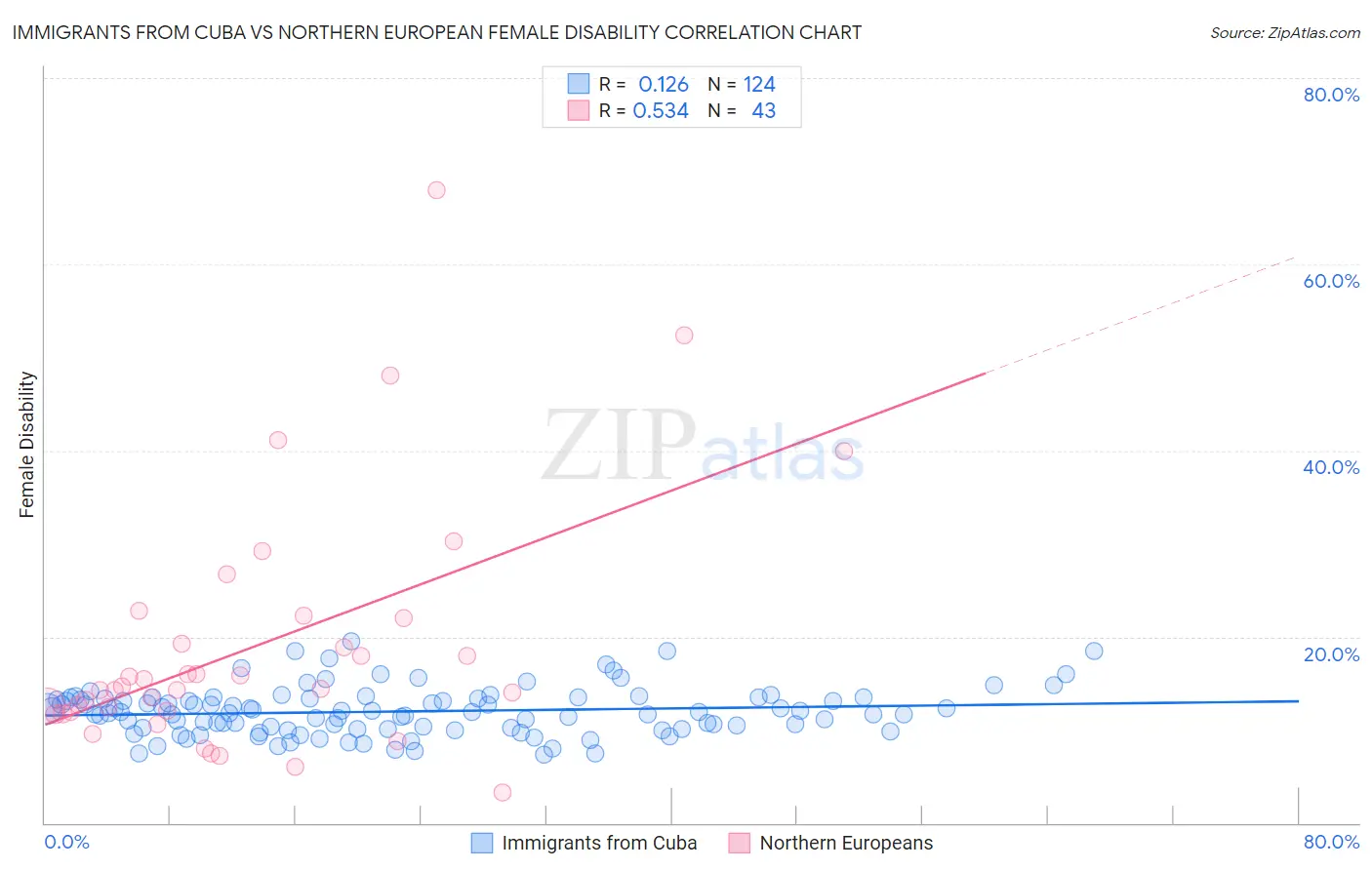Immigrants from Cuba vs Northern European Female Disability
COMPARE
Immigrants from Cuba
Northern European
Female Disability
Female Disability Comparison
Immigrants from Cuba
Northern Europeans
12.4%
FEMALE DISABILITY
20.2/ 100
METRIC RATING
206th/ 347
METRIC RANK
12.3%
FEMALE DISABILITY
27.5/ 100
METRIC RATING
193rd/ 347
METRIC RANK
Immigrants from Cuba vs Northern European Female Disability Correlation Chart
The statistical analysis conducted on geographies consisting of 325,981,608 people shows a poor positive correlation between the proportion of Immigrants from Cuba and percentage of females with a disability in the United States with a correlation coefficient (R) of 0.126 and weighted average of 12.4%. Similarly, the statistical analysis conducted on geographies consisting of 406,028,817 people shows a substantial positive correlation between the proportion of Northern Europeans and percentage of females with a disability in the United States with a correlation coefficient (R) of 0.534 and weighted average of 12.3%, a difference of 0.38%.

Female Disability Correlation Summary
| Measurement | Immigrants from Cuba | Northern European |
| Minimum | 7.3% | 3.3% |
| Maximum | 19.6% | 68.0% |
| Range | 12.3% | 64.7% |
| Mean | 12.0% | 18.9% |
| Median | 11.9% | 14.4% |
| Interquartile 25% (IQ1) | 10.1% | 12.0% |
| Interquartile 75% (IQ3) | 13.4% | 22.0% |
| Interquartile Range (IQR) | 3.3% | 10.0% |
| Standard Deviation (Sample) | 2.5% | 13.1% |
| Standard Deviation (Population) | 2.5% | 13.0% |
Demographics Similar to Immigrants from Cuba and Northern Europeans by Female Disability
In terms of female disability, the demographic groups most similar to Immigrants from Cuba are Croatian (12.4%, a difference of 0.0%), Immigrants from Grenada (12.4%, a difference of 0.020%), Immigrants from Zaire (12.3%, a difference of 0.040%), Immigrants from Barbados (12.3%, a difference of 0.050%), and Somali (12.3%, a difference of 0.070%). Similarly, the demographic groups most similar to Northern Europeans are Ukrainian (12.3%, a difference of 0.010%), Swedish (12.3%, a difference of 0.040%), Immigrants from Western Africa (12.3%, a difference of 0.080%), Armenian (12.3%, a difference of 0.10%), and Immigrants from Panama (12.3%, a difference of 0.10%).
| Demographics | Rating | Rank | Female Disability |
| Immigrants | Albania | 31.6 /100 | #189 | Fair 12.3% |
| Immigrants | Honduras | 31.3 /100 | #190 | Fair 12.3% |
| Armenians | 29.7 /100 | #191 | Fair 12.3% |
| Immigrants | Western Africa | 29.2 /100 | #192 | Fair 12.3% |
| Northern Europeans | 27.5 /100 | #193 | Fair 12.3% |
| Ukrainians | 27.2 /100 | #194 | Fair 12.3% |
| Swedes | 26.6 /100 | #195 | Fair 12.3% |
| Immigrants | Panama | 25.5 /100 | #196 | Fair 12.3% |
| Hondurans | 25.4 /100 | #197 | Fair 12.3% |
| Mexican American Indians | 24.9 /100 | #198 | Fair 12.3% |
| Immigrants | Trinidad and Tobago | 24.7 /100 | #199 | Fair 12.3% |
| Trinidadians and Tobagonians | 22.4 /100 | #200 | Fair 12.3% |
| Chinese | 22.1 /100 | #201 | Fair 12.3% |
| Somalis | 21.5 /100 | #202 | Fair 12.3% |
| Immigrants | Barbados | 21.1 /100 | #203 | Fair 12.3% |
| Immigrants | Zaire | 20.9 /100 | #204 | Fair 12.3% |
| Immigrants | Grenada | 20.5 /100 | #205 | Fair 12.4% |
| Immigrants | Cuba | 20.2 /100 | #206 | Fair 12.4% |
| Croatians | 20.2 /100 | #207 | Fair 12.4% |
| Basques | 17.5 /100 | #208 | Poor 12.4% |
| Mexicans | 15.7 /100 | #209 | Poor 12.4% |